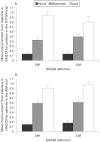Validation of the 28-joint Disease Activity Score (DAS28) and European League Against Rheumatism response criteria based on C-reactive protein against disease progression in patients with rheumatoid arthritis, and comparison with the DAS28 based on erythrocyte sedimentation rate
- PMID: 18490431
- PMCID: PMC2674547
- DOI: 10.1136/ard.2007.084459
Validation of the 28-joint Disease Activity Score (DAS28) and European League Against Rheumatism response criteria based on C-reactive protein against disease progression in patients with rheumatoid arthritis, and comparison with the DAS28 based on erythrocyte sedimentation rate
Abstract
Objective: To validate and compare the definition of the Disease Activity Score 28 based on C-reactive protein (DAS28 (CRP)) to the definition based on erythrocyte sedimentation rate (ESR).
Methods: Data were analysed from two randomised, double-blind, placebo-controlled trials of abatacept of 6-month and 12-month duration in patients with rheumatoid arthritis. European League Against Rheumatism (EULAR) response criteria and the proportion of patients in remission (DAS28 <2.6) based on the two DAS28 definitions were examined. Trends in radiographic progression (erosion score, joint space narrowing score and total score) and physical function (Health Assessment Questionnaire Disability Index (HAQ-DI)) across the EULAR responder states (none, moderate and good) were analysed.
Results: There was general agreement in determining the EULAR responder state using both DAS28 definitions (kappa = 0.80, 95% CI 0.76 to 0.83). Overall, there was 82.4% agreement on the EULAR response criteria; when disagreements occurred, the DAS28 (CRP) yielded a better EULAR response more often then DAS28 (ESR) (12.6% vs 4.9%, respectively). There was also agreement in determining remission: kappa = 0.69 (95% CI 0.60 to 0.78). Radiographic progression decreased in patients treated with abatacept across EULAR states (from none to moderate to good) based on both definitions. For patients treated with placebo, the trend was not as pronounced, with radiographic scores higher for moderate vs non-responders. For physical function, similar trends were observed across the EULAR states for both DAS28 definitions.
Conclusions: The DAS28 (CRP) has been validated against radiographic progression and physical function. While the DAS28 (CRP) yielded a better EULAR response more often than the DAS28 (ESR), the validation profile was similar to the DAS28 (ESR), indicating that both measures are useful for assessing disease activity in patients with rheumatoid arthritis.
Conflict of interest statement
Figures


References
-
- Felson DT, Anderson JJ, Boers M, Bombardier C, Furst D, Goldsmith C, et al. American College of Rheumatology. Preliminary definition of improvement in rheumatoid arthritis. Arthritis Rheum 1995;38:727–35 - PubMed
-
- Prevoo ML, van’t Hof MA, Kuper HH, van Leeuwen MA, van de Putte LB, van Riel PL. Modified disease activity scores that include twenty-eight-joint counts. Development and validation in a prospective longitudinal study of patients with rheumatoid arthritis. Arthritis Rheum 1995;38:44–8 - PubMed
-
- Fransen J, van Riel PL. The Disease Activity Score and the EULAR response criteria. Clin Exp Rheumatol 2005;23:S93–9 - PubMed
-
- van Gestel AM, Haagsma CJ, van Riel PL. Validation of rheumatoid arthritis improvement criteria that include simplified joint counts. Arthritis Rheum 1998;41:1845–50 - PubMed
Publication types
MeSH terms
Substances
LinkOut - more resources
Full Text Sources
Other Literature Sources
Medical
Research Materials
Miscellaneous

